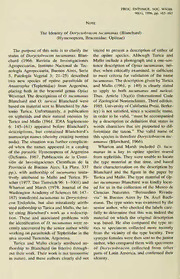
The Identity Of Doryctobracon Tucumanus (Blanchard) (Hymenoptera, Braconidae: Opiinae) PDF
Preview The Identity Of Doryctobracon Tucumanus (Blanchard) (Hymenoptera, Braconidae: Opiinae)
PROC. ENTOMOL. SOC. WASH. 98(1), 1996, pp. 162-163 Note The Identity of Doryctobracon tucumanus (Blanchard) (Hymenoptera, Braconidae: Opiinae) The purpose of this note is to clarify the intend to present a description of either of status of Doryctobracon tucumanus. Blan- the opiine species. Although Turica and chard (1966. Revista de Investigaciones Mallo include a photograph and a one-sen- Agropecuarias, Instituto Nacional de Tec- tence description of Opius tucumanus, nei- nologia Agropecuaria, Buenos Aires, Serie ther, when critically examined, is sufficient 5, Patologia Vegetal 3: 21-25) described to meet criteria for validation of the name two new species of opiine parasitoids of tucumanus. The description given by Turica Anastrepha (Tephritidae) from Argentina, and Mallo (1961, p. 149) is clearly stated placing both in the braconid genus Opius to apply to both tucumanus and turicai. Wesmael. The descriptions ofO. tucumanus Thus, Article 13(a)(i) (International Code Blanchard and O. turicai Blanchard were of Zoological Nomenclature, Third edition. based on material sent to Blanchard by An- 1985. University ofCaliforniaPress, Berke- tonio Turica. Unfortunately, a publication ley) is not satisfied, since a scientific name, on tephritids and their natural enemies by in order to be valid, "must be accompanied Turica and Mallo (1961. IDIA Suplemento by a description or definition that states in 6: 145-161) appeared before Blanchard's words characters that are purported to dif- descriptions, but contained Blanchard's ferentiate the taxon." The valid name of manuscript names (thereby creating nomina this species is therefore Doryctobracon tuc- nuda). The situation was further complicat- umanus (Blanchard, 1966). ed when the names appeared in a catalog Wharton and Marsh included D. tucu- of the parasitic Hymenoptera of Argentina manus in a key to opiine species reared (DeSantis. 1967. Publicacion de la Comi- from tephritids. They were unable to locate sion de Investigaciones Cientificas de la the type material at that time, and based Provincia de Buenos Aires. La Plata. 337 their characterization on the description by pp.), with authorship of tucumanus tenta- Blanchard and the figure in the paper by tively attributed to Mallo and Turica. Fi- Turica and Mallo. The type material of Op- scher (1977. Das Tierreich 96: 1-1001) and ius tucumanus Blanchard was kindly locat- Wharton and Marsh (1978. Journal of the ed for us in the collection of the Museo de Washington Academy of Sciences 68: 147- Ciencias Naturales "Bernardino Rivada- 167) transferred tucumanus to Doryctobra- via" in Buenos Aires by Dr. Axel Bach- con Enderlein, but also mistakenly attrib- mann. The type series was examined by the uted authorship to Turica and Mallo, the lat- senior author, who checked the labels care- ter citing Blanchard's work as a redescrip- fully to determine that this was indeed the tion. These and associated problems with material on which the original description the identification of D. tucumanus were re- was based. He also compared the type se- cently uncoveredby the senior author while ries to specimens collected more recently working on parasitoids ofTephritidae in the from the vicinity of the type locality. Two area around Tucuman, Argentina. syntype females were then sent to thejunior Turica and Mallo clearly attributed au- author, who compared them with specimens thorship to Blanchard (in litteris) through- of Doryctobracon collected from other out their work. Their work is not taxonomic parts of Latin America, and confirmed their in nature, and these authors clearly did not identity. VOLUME NUMBER 98, 1 163 Wharton and Marsh misread Blanchard's species of Doryctobracon are provided by description and statedthatthe fore and mid- Fischer (1977; 1980. Polskie Pismo Ento- dle tibiae and femora were dark brown to mologiczne 50: 215-269). black. Blanchard, however, correctly noted To further clarify the status of D. tucu- that only the hind legs were darkened. The manus, we herein designate a lectotype type material ofD. tucumanus thus runs di- from Blanchard's syntype series in the Mu- rectly to Doryctobracon areolatus (Szepli- seo de Ciencias Naturales "Bernardino Ri- geti, 1911. Bolletino del Laboratorio di vadavia." The lectotype female bears the A Zoologia Generale e Agraria, Portici 5: following labels: 1) Loreto Mis. XI-58 285-286) in the key included in the publi- Turica 1. [handwritten in blue ink with the cation by Wharton and Marsh. Comparison following additional data on the reverse of the syntype females with specimens of side:] exAnastrepha s/ubajay 2) Col E. E. D. areolatus collected in Mexico, Costa Blanchard [printed in black ink] 3) Ms. Rica, Brazil, and Argentina shows that D. Arg. Cs. Nat. [printedin black ink] 4) ejem- tucumanus (Blanchard) is a junior subjec- plar perteneciente a la serie tipica A. Roig tive synonym ofthe widespreadAnastrepha A. 1993 [handwritten in black ink on pink parasitoid D. areolatus (Szepligeti) (new paper] 5) LECTOTYPE Opius tucumanus synonym). Doryctobracon areolatus is Blanchard, 1966 det. Wharton 1994 [hand- most readily recognized by the following written in black ink on red label] combination of characters: propodeum are- We are especially grateful to Dr. Axel olate; head and fore and middle coxae, fem- Bachmann for locating Blanchard's type ora, and tibiae yellow to yellow-orange; material, and for comments on the publi- meso- and metasoma generally yellow to cation by Turica and Mallo. We also thank yellow-orange, though mesoscutum often Dr Roberto Zucchi for assistance with darker, and apical abdominal terga frequent- specimens. ly darkened, especially in males; wings varying from hyaline to slightly dusky, nev- Sergio M. Ovruski, CIRPON, Pje. Cas- er banded or with pale spots; hind tibia dark eros 1050, 4000-San Miguel Tucumdn, Ar- at least apically and basally, and nearly al- gentina; Robert A. Wharton, Departmentof A&M ways with a distinct pale band medially. Entomology, Texas University, Col- More complete descriptions of the known lege Station, TX, 77843, U.S.A.
